Investigative Stories
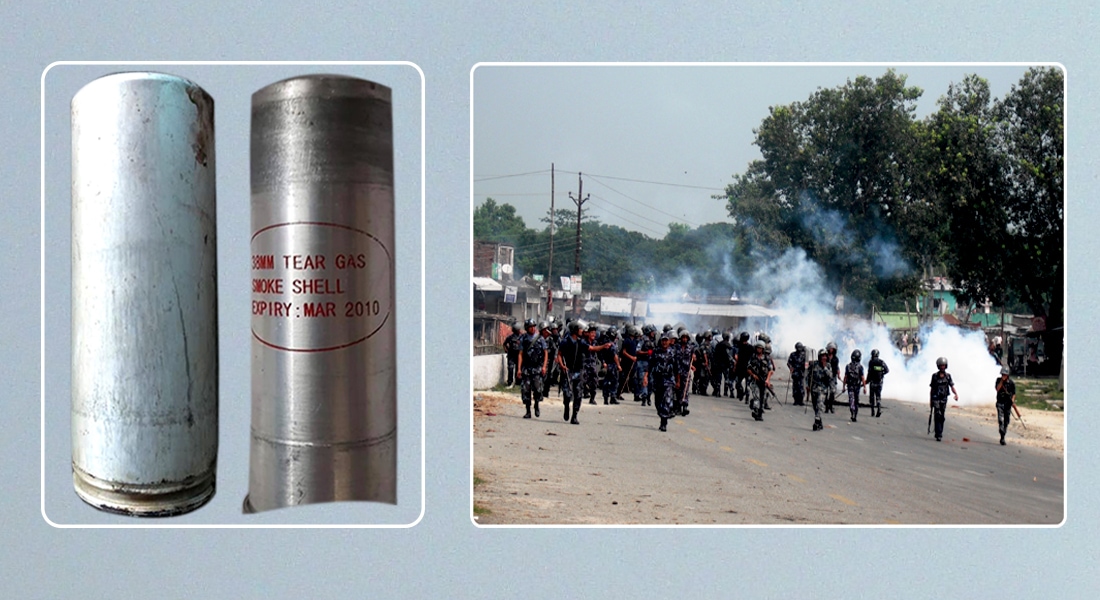
On 15 August 2019, police fired several rounds of tear gas shells at the supporters of Rabi Lamichhane, a Television journalist, who was taken into police custody on charge of abetting former colleague Shalikram Pudasaini to commit suicide. The crowd was arriving to encircle Chitwan District Administration Office demanding that Lamichhane be released. And tear gas shells were fired to scatter the crowd.
The tear gas firing case, however, exposed a shocking reality; tear gas unleashed at the crowd was expired nine years ago. This picture (see the picture) obtained from the site shows the date of tear gas used to disperse the crowd was expired in March 2010.
Even as the tear gas firing case revealed that date expired tear gas shells are being used for crowd control, police in Chitwan didn’t respond to the Right to Information application filed there seeking details about the stockpile of expired tear gas shells.
“Most tear gas shells are date expired”
Globally, security agencies use tear gas to control crowds. But this has prompted debate across the world over whether tear gas, which causes serious health hazards, should be used for riot control. Those advocating for public health affairs and human rights argue use of tear gas should be banned.
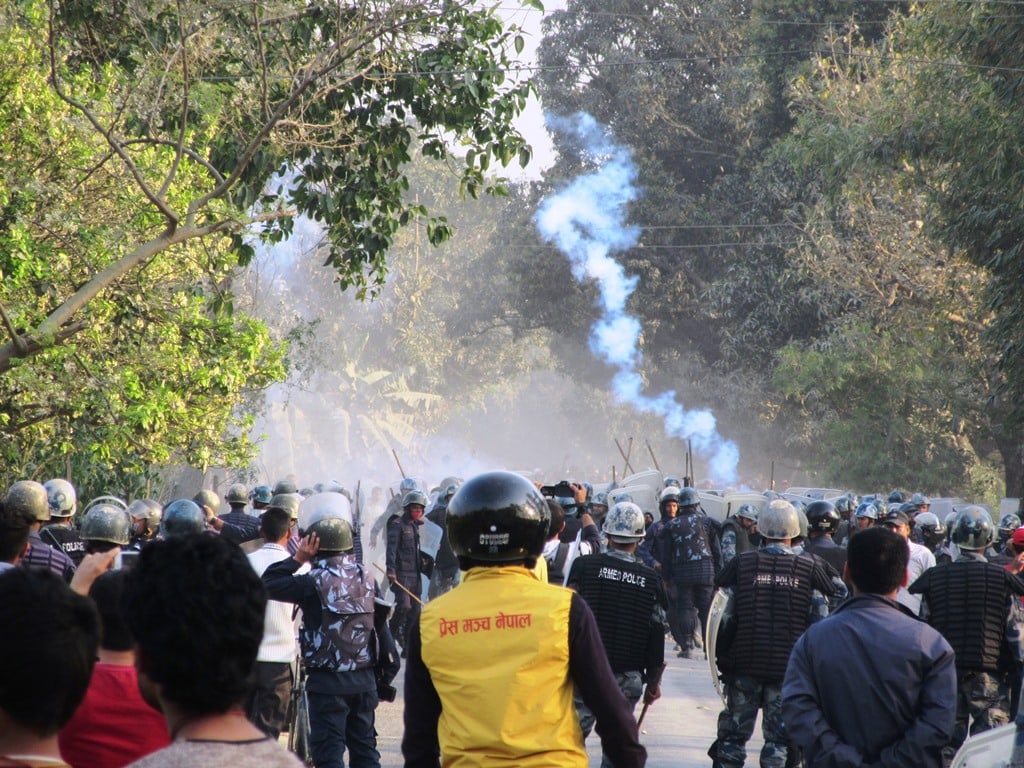
“Alternative of tear gas must be explored. Experts can hold extensive discussions to seek alternatives. Since the toxic smoke causes huge damage to the crowd or group alternatives must be explored,” said Dr. Sharad Oanta, a public health expert.
The Nepal police is the main security agency using tear gas. The recent case has exposed sheer negligence of police in using asphyxiants.
But this was not the first case of such negligence. A report prepared by the National Human Rights Commission had earlier concluded that police lobbed date expired tear gas to control an angry mob in Maleth of Saptari, Biratnagar and Surkhet during 2017’s Madhes protests.
“We had conducted a forensic test to confirm after the police were found using date expired tear gas shells,” said NHRC member Mohna Ansari adding, “The then IGP Prakash Aryal was instructed to inquire about the use of date expired tear gas shells and destroy them.”
But the police never implemented the commission’s instruction. Yet, two years later a similar incident occurred in Bharatpur, Chitwan.
Multiple complications have emerged after date expired tear gas shells were used to control riot in the past.
For example when the then SP Pushkar Karki was transferred to Kaski in 2010 he asked police officials to inquire about the state of tear gas shells. Reason: Anti-constitution protests had flared in the district shortly after he took charge as police chief.
The reality was dreadful. “All 200 tear gas shells were expired. I immediately requested headquarters and replaced those tear gas shells with new ones,” said Karki, who recently retired as AIGP.
Details provided by police headquarters show the Nepal Police plans to procure 4000 tear gas shells for fiscal year 2019-20 whereas 5000 tear gas shells were purchased in fiscal year 2018-2019 and 100,00 shells before that.
The Police never know the actual demand of tear gas as it fluctuates annually.
Asked about shifting demand, former police spokesperson ans current AIG Shailesh Thapa said they purchase tear gas as per demand. But police headquarters couldn’t disclose exact details about use of tear gas shells and what portion of purchased gas shells were used or whether they were just dumped in recent years despite several requests. “Tear gas canisters are sent to several police offices so it’s not easy to calculate how many have been used or remain unused. They are used in course of training too. Generally, police headquarters don't get real time updates about use or stockpile of those materials.”
Tear gas shells bearing a certain expiration date thus should be used within the stated period “Since there is no tear gas refinery technology in Nepal to reuse them, the only option is to destroy unused items,” said police spokesperson Thapa.
But retired police officers admitted that expired tear gas shells are also used to control riots. Storekeepers themselves sent expired tear gas shells to some areas, according to them.
“I can’t say what is exactly happening there. But most tear gas shells expired just a few years ago. Due to expiration some of them hadn’t worked when fired,” said former DIG Hemant Malla.
Lethal CN gas
The Nepal Police uses batons for crowd control before firing tear gas. If crowd control efforts go futile despite charging batons then police shoot below the knee exercising right enabled by the Local Administration Act (1971).
Details obtained from police headquarters show Nepal Police is using six types of tear gas shells—38 CM, gas grenade smoke, simple gas grenade, dual fire shell, long range and vehicle electronic gas. They are classified based on techniques and equipment used to fire the shells.
Based on the composition of chemicals, however, police use only two types of tear gas canisters—CS tear gas and CN tear gas.
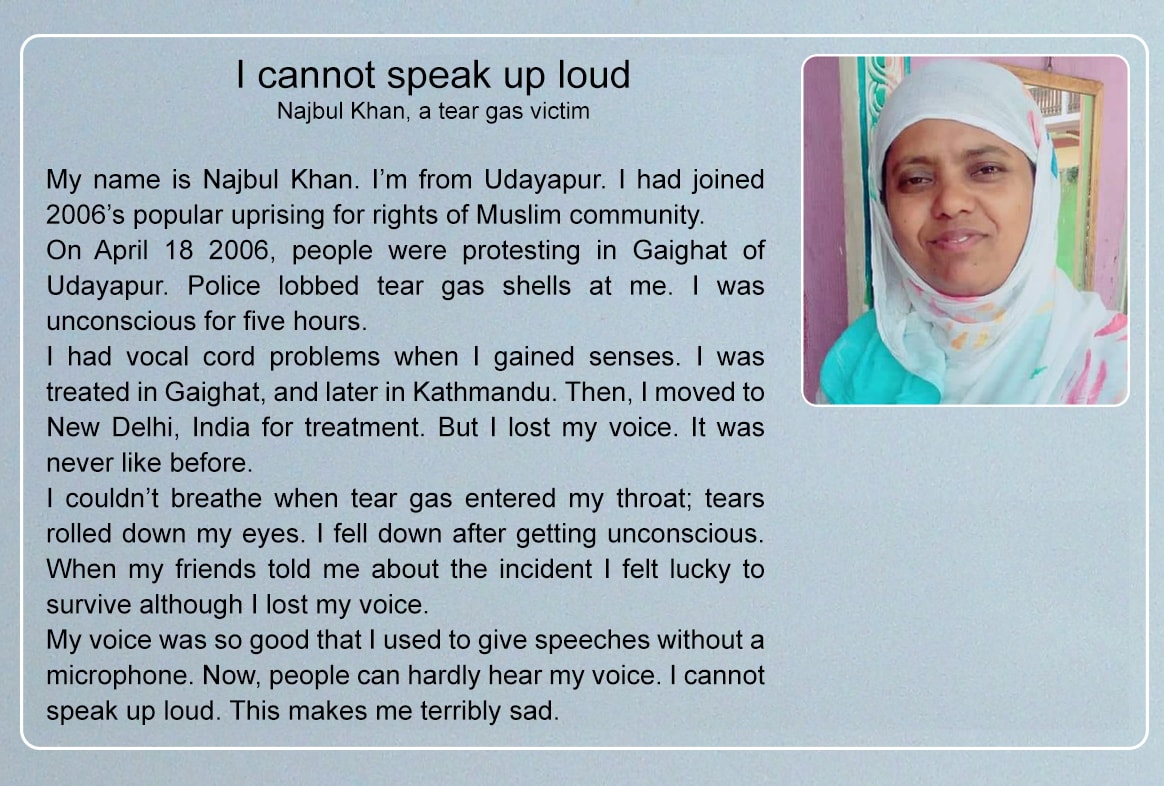
The 1993’s Chemical Weapons’ Convention banned the use of CN gas, according to the Journal of Environmental Analytical Chemistry. A year after the convention many countries except Angola, Egypt, North Korea signed on the convention.
But its use has not been completely stopped. The Nepal Police is also using the same CN gas that too often expired ones. Asked whether they are using expired tear gas shells because of shortage, police spokesperson Thapa didn’t admit it.
“There might be shortage in some units but there is no shortage overall. We annually purchase tear gas. Also, we purchase based on necessity so there is no shortfall at all,” he claimed.
If so, why are police using expired tear gas shells?
Former DIG Malla believes procurement issues are linked behind the use of expired tear gas.
“Debate over inadequate dress allowance is too common. The Nepal Police never gets enough budget for dress procurement so they have to manage as much as they get,” said Malla adding, “Budget is never hiked despite increased workforce and need and issue of tear gas can’t remain unaffected from this tendency.”
Police officers, however, blame people’s growing anarchist conduct as responsible behind use of tear gas. Unlike in the past, protesters never disperse when warnings are issued or batons on protesters are charged, they argue. Since police need to use tear gas increasingly to disperse crowds, they cannot procure the item when needed. Thus they use expired tear gas, too.
Police have rarely encountered major political protests or uprising in recent years. This means they haven’t used tear gas for the last three to four years. Thus, this could also be one of the reasons behind use of expired tear gas.
“We cannot buy new unless we exhaust our old stock” said a senior police officer seeking anonymity, “If protests flare right now, we will be using the tear gas we already have, which are mostly expired for I had never seen those expired items being replaced with new ones.''
Police spokesperson Thapa, however, claimed that the expired tear gas shells are destroyed in accordance with due procedure. Asked if the police had not used even a single expired tear gas shell, he blamed field commanders.
“Expired tear gas can be used if the local commander is not aware about it. But we don’t have institutional policy to use expired tear gas,” said Thapa.
Health Hazards
The story of Najbul Khan, a local of Udayapur elaborates how tear gas poses a threat to public health. On April 18, 2006, she joined the popular protest. Police unleashed tear gas at her. When Khan regained her senses--five hours after the accident--her voice was not as normal as it was earlier.

“I was treated even in New Delhi but my voice is not normal as it was in the past,” said Khan. [Details below]
Several conclusions about negative impacts of tear gas are available in the public domain. Study reports say that tear gas is a chemical weapon that causes every severe eye and respiratory pain, skin irritation, bleeding and blindness.
According to the Journal of Environmental Analytical Chemistry, 2015, tear gas used across the globe is hazardous for health. The journal states the toxic smoke blinds eyes up to 15 minutes, causes vomiting and serious ear, nose and throat problems, including permanent blindness or even death.
Setu BK of Nepalgunj died after police fired tear gas at her when she was participating in a peaceful protest in 2006. “On April 16, Setu BK of the then Bageshwori Ward-3 was injured after police fired tear gas at her when she was participating in the protest and died on her way to Lucknow for treatment,” states a field report prepared by INSEC, a human rights organization.
“It temporarily inactivates our nerves and seriously affects eyes and lungs or may cause death if the body is weak,” said Rameshwor Adhikari, a professor at Tribhuvan University’s Department of Chemistry. “Tear gas is too dangerous as it destroys human cells and entirely affects their activities.”
As negative impacts of tear gas are reported everywhere voices are raised across the globe including Nepal to stop its use.
Dhananjaya Khanal had filed a writ petition at the Supreme Court in 2006 demanding that use of tear gas be banned. Responding to the writ petition, the apex court had ordered the government to study the matter by forming an expert panel comprising the officials from agencies concerned—health, home affairs and police headquarters.
“What are other alternatives to this gas? Is it effective to maintain law and order if local administration follows other ways. Submit a report by studying these issues and make additional arrangements accordingly,” the court stated in its order.
The order has not been implemented so far.
Experts say expired tear gas is more lethal. “Generally, when chemicals are stored for long, it becomes totally different from previous form,” said Prof. Adhikari.
So, how lethal is it? “Since tear gas is kept inside a rubber or plastic it doesn’t get reactive unless it gets in touch with outside matter,” said Prof. Adhikari adding, “It’s poisonous quality remains intact. It’s not clear whether it becomes more poisonous after the expiration. Its efficiency, however, is weakened automatically when not used for long.” Weakened efficiency is the most lethal aspect of any chemical.
The key reason to use tear gas is to avoid the use of lethal weapons and disperse the crowd without using them.
“If a tear gas shell is expired it doesn’t work or remains ineffective even if it explodes. Given that context police have to excessive force,” said Malla adding, “And it might cause huge accidents or loss when excessive force is used when use of minimal force is to be exercised.”
More Investigative Stories
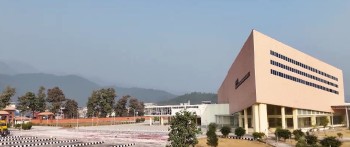
What’s behind Nepal’s convention halls construction frenzy?
Large-scale convention halls constructed with the expense of Rs 26 billion are not in use. Many such halls, built without...
Hundreds of Nepalis are languishing in foreign jails without legal help
Over a thousand Nepalis are behind bars in Malaysia and gulf countries without access to lawyers or family members. With...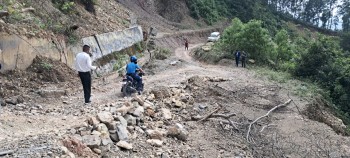

Comment Here